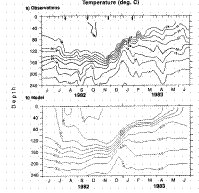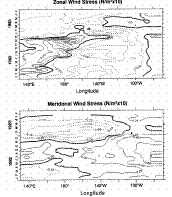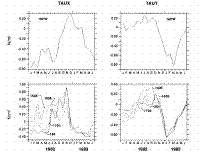U.S. Dept. of Commerce / NOAA / OAR / PMEL / Publications
Ocean Model Studies of Upper-Ocean Variability at 0°N, 160°W during the 1982–1983
ENSO: Local and Remotely Forced Response
D.E. Harrison
NOAA, Pacific Marine Environmental Laboratory, 7600 Sand Point Way NE, Seattle, WA
98115
A.P. Craig
School of Oceanography, University of Washington, Seattle, WA 98195
Journal of Physical Oceanography, 23(3), 426-451 (1993)
Copyright ©1993 American Meteorological Society. Further electronic distribution is not
allowed.
2. Comparison of observations at 0°N, 160°W and SADLER hindcast results
Figures 1a and 2a
present the depth-time plots of zonal current and temperature from Firing
et al. (1983). The interval between July 1982 and March 1983 will be focused
upon because the currents went through the largest variations during this time.
From mid-June 1982 to mid-September 1982, the core of the EUC decelerates from
over 80 cm s maximum speed eastward to westward
flow at about 120-m depth. From mid-October 1982 to mid-November 1982, eastward
acceleration of the surface flow forms a strong surface-trapped jet with weak
westward flow just beneath it. From mid-November 1982 to mid-January 1983, the
eastward surface jet decelerates rapidly and the surface flow becomes westward
while the deep flow accelerates eastward late in this period. By mid-February,
the EUC has returned. During the spring, the EUC shallows slightly and surface
flow returns to more normal conditions.
maximum speed eastward to westward
flow at about 120-m depth. From mid-October 1982 to mid-November 1982, eastward
acceleration of the surface flow forms a strong surface-trapped jet with weak
westward flow just beneath it. From mid-November 1982 to mid-January 1983, the
eastward surface jet decelerates rapidly and the surface flow becomes westward
while the deep flow accelerates eastward late in this period. By mid-February,
the EUC has returned. During the spring, the EUC shallows slightly and surface
flow returns to more normal conditions.

Figure 1. Zonal velocity during 1982-1983. (a) profiles from Firing et al.
(1983) at (0°, 159°W), (b) results from the model using the SADLER wind stress
field (Harrison
et al. 1989) at 0°N, 160°W. The contour interval is 20 cm s in both plots.
in both plots.

Figure 2. As for Fig. 1, except for temperature. The contour interval is
2°C.
There is also interesting thermal evolution (Fig.
2a) during the same period. In July, there is rapid warming throughout the
water column. From August 1982 to November 1982, there is weak warming above
160 m. Water warmer than 30° appears above 70 m in October. From late November
1982 through January 1983, there is shoaling and intensification of the thermocline.
During this period the thermocline is very sharp and the 28° and 18°C isotherms
are separated by only about 30 m. In January there is rapid warming of water
colder than 18°C. From February 1983 through spring 1983, the thermocline gradient
weakens dramatically as isotherms greater than 22°C continue to rise while isotherms
less than 22°C deepen.
Figures 1b and 2b
present the corresponding fields from the SADLER hindcast experiment. The hindcast
reproduces all of the major features of the observational data, with scales
of variability close to those observed. The largest discrepancies are in the
delayed return of the EUC in 1983 in the hindcast, and the differences in the
near-surface temperatures before July 1982 and after April 1983. Otherwise,
these timing discrepancies are typically smaller than one month, which is the
resolution of the imposed monthly mean wind stress field of the hindcast. This
is at least as successful a longterm simulation of observations as any known
to the authors; the hindcast has quantitative skill, in the sense discussed
by Harrison
et al. (1989), between July 1982 and January 1983.
Figure 3 presents the equatorial zonal and meridional
wind stress fields for the SADLER hindcast experiment as a function of longitude
and time. These wind stress fields were calculated by multiplying the SADLER
pseudostress results by a drag coefficient of 1.2 × 10 and air density of 1.2 × 10
and air density of 1.2 × 10 gm cm
gm cm (Harrison
et al. 1989). This C
(Harrison
et al. 1989). This C value is consistent with the values of Large
and Pond (1981) for the windspeed range of this area over this period. Climatologically
there are easterlies across the region between 160°W and 160°E throughout the
seasonal cycle (see Harrison
et al. 1989 for more comparison between the 1982-83 stresses and the climatological
stresses), so that the westerlies and weak easterlies found during 1982 are
strongly anomalous, as are the strong meridional winds in late 1982 through
early 1983.
value is consistent with the values of Large
and Pond (1981) for the windspeed range of this area over this period. Climatologically
there are easterlies across the region between 160°W and 160°E throughout the
seasonal cycle (see Harrison
et al. 1989 for more comparison between the 1982-83 stresses and the climatological
stresses), so that the westerlies and weak easterlies found during 1982 are
strongly anomalous, as are the strong meridional winds in late 1982 through
early 1983.

Figure 3. SADLER analysis of the monthly mean zonal and meridional wind
stress along the equator, 1982-1983. The contour interval is 0.02 N m in both plots.
in both plots.
Figure 4 presents time series of zonal and meridional
stress at 160°W as well as at several longitudes west of 160°W. With the short
periods of enhanced westerly wind west of the date line and the abrupt termination
of the period of westerlies in December 1982, linear theory predicts that Kelvin
pulses will be generated and then propagate eastward away from the region of
westerly winds. Eastward propagation of the zonal stress forcing occurs during
some periods; this can affect the rate at which remote response occurs (Harrison
and Schopf 1984) or lead to resonant Kelvin forcing (McCreary
and Lukas 1986). A number of papers have discussed the elements of the physics
of forced Kelvin pulses (see, e.g., Giese
and Harrison 1990). At the observation site (0°, 160°W) there is also substantial
local wind forcing, however, so the behavior there will likely also depend on
the local forcing. In the next section, we examine how much of the response
is produced by local forcing.

Figure 4. Time series of equatorial zonal and meridional wind stress at
160°W and at several longitudes west of 160°W.
Return to previous section or go to next
section
PMEL Outstanding Papers
PMEL Publications Search
PMEL Homepage
 maximum speed eastward to westward
flow at about 120-m depth. From mid-October 1982 to mid-November 1982, eastward
acceleration of the surface flow forms a strong surface-trapped jet with weak
westward flow just beneath it. From mid-November 1982 to mid-January 1983, the
eastward surface jet decelerates rapidly and the surface flow becomes westward
while the deep flow accelerates eastward late in this period. By mid-February,
the EUC has returned. During the spring, the EUC shallows slightly and surface
flow returns to more normal conditions.
maximum speed eastward to westward
flow at about 120-m depth. From mid-October 1982 to mid-November 1982, eastward
acceleration of the surface flow forms a strong surface-trapped jet with weak
westward flow just beneath it. From mid-November 1982 to mid-January 1983, the
eastward surface jet decelerates rapidly and the surface flow becomes westward
while the deep flow accelerates eastward late in this period. By mid-February,
the EUC has returned. During the spring, the EUC shallows slightly and surface
flow returns to more normal conditions.

 and air density of 1.2 × 10
and air density of 1.2 × 10 value is consistent with the values of
value is consistent with the values of 
 in both plots.
in both plots.